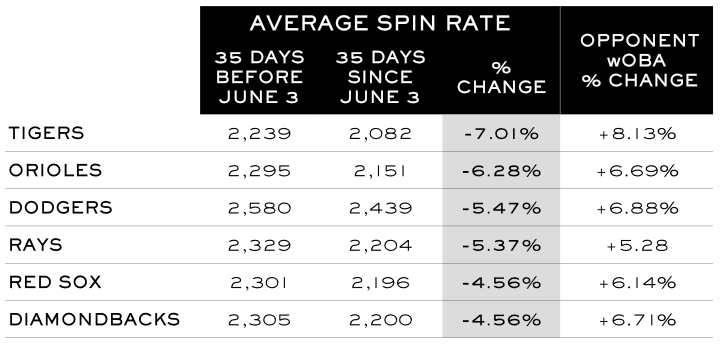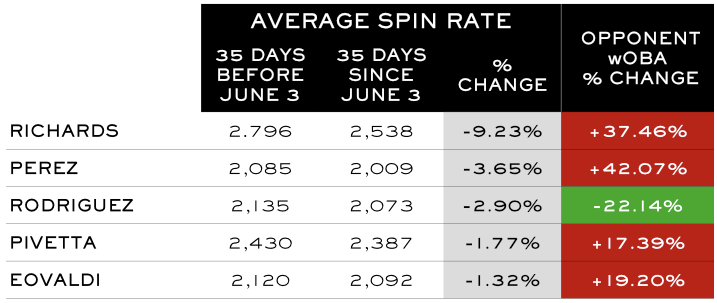It’s been 35 days since Major League Baseball first warned teams of repercussions for pitchers using rule-violating “sticky stuff.” For this analysis, RSNStats compared the games of the last 35 days since the June 3rd warning with the 35 days of games leading up to June 3rd. The results show a clear decline in pitchers’ average spin rate and a clear uptick in opponents’ offensive production. What they do not show is correlation between these two results.
Across baseball
Across the board, when comparing the “before” period to the “after” period, average spin rates dropped for all 30 Major League teams, though the percent of change between the two periods varied widely, from a 7% reduction on the high end for the Tigers pitching staff to just a 0.1% reduction own the low end for Twins hurlers.
The Red Sox staff’s average spin rate fell 4.5 percent in the comparison, which was the fifth biggest drop, by percent, in baseball. Overall, the average spin rate reduction across the 30 big league teams was 3.01 percent.
At the same time, 21 of the 30 Major League teams experienced better offense when comparing the same periods and as measured by weighted on-base average (wOBA), a key measure of offensive production. The Red Sox wOBA moved from .326 in the before period to .346 in the after period, an improvement of 6.14 percent. The average improvement in wOBA for all 30 teams was 3.3 percent.
As shown in this table, for the teams with the six biggest reductions in average spin rate, opponents’ improvements in wOBA far outpaced the average increase. Opponents facing the Tigers, for example, recorded a wOBA that was more than eight percent better in the after period as compared to the before period.
But the data doesn’t always correlate. Opponents against the Yankees, a team with lower than average reduction of average spin rate (down 2.3%) saw opponents’ wOBA climb a remarkable 18.7 percent (from .278 to .330). Data for the Royals tells a similar story. Their average spin rate dropped by less than 1% and yet opponents recorded a 16.8% increase in wOBA (from .322 to .376).
Red Sox pitchers
All five Red Sox starters had a reduction in average spin rate over the comparison periods, but none saw a greater impact than Garrett Richards (down 9.2%). And while opponents’ wOBA against Richards spiked more than 37 percent, it’s worth noting that opponents facing Martín Pérez were more than 42% more effective in the after period, despite Pérez’ relatively small drop in average spin rate (3.65%).
Of the five Red Sox starters only Eduardo Rodriguez held opponents more effectively in the after period, with a 22% reduction in opponents wOBA, from .411 to .320.



 Updated — The online voters have spoken and they’re sending Red Sox star
Updated — The online voters have spoken and they’re sending Red Sox star